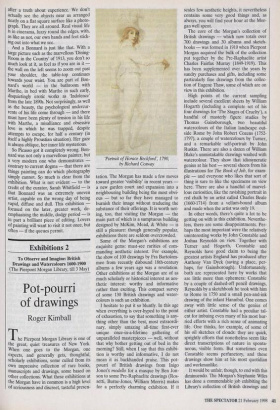Exhibitions 2
To Observe and Imagine: British Drawings and Watercolours 16(10-1900 (The Pierpont Morgan Library, till 3 May)
Pot-pourri of drawings
Roger Kimball
The Pierpont Morgan Library is one of the great, quiet treasures of New York. When one goes to the Morgan, one expects, and generally gets, thoughtful, scholarly exhibitions, some culled from its own impressive collection of rare books, manuscripts and drawings, some based on other collections. What these exhibitions at the Morgan have in common is a high level of seriousness and discreet, tasteful presen- `Portrait of Horace Beckford, 1790, by Richard Cosway tation. The Morgan has made a few moves toward greater 'visibility' in recent years a new garden court and expansion into a neighbouring building being the most obvi- ous — but so far they have managed to burnish their image without traducing the substance of their offerings. It is worth not- ing, too, that visiting the Morgan — the main part of which is a sumptuous building designed by McKim, Mead, & White — is still a pleasure: though generally popular, exhibitions there are seldom overcrowded.
Some of the Morgan's exhibitions are exquisite gems: must-see rarities of com- manding aesthetic interest. For example, the show of 100 drawings by Fra Bartolom- meo from recently disbound 18th-century albums a few years ago was a revelation. Other exhibitions at the Morgan are of as much scholarly or historical interest as aes- thetic interest: worthy and informative rather than exciting. This compact survey of some 130 British drawings and water- colours is such an exhibition.
I hesitate to put it so bluntly. In this age when everything is over-hyped to the point of exhaustion, to say that something is any- thing other than the best, most extraordi- nary, simply amazing all-time first-ever unique once-in-a-lifetime gathering of unparalleled masterpieces — well, without that why bother getting out of bed in the morning? Still, when I say that this exhibi- tion is worthy and informative, I do not mean it as backhanded praise. This pot- pourri of British drawings from Inigo Jones's modello for a masque by Ben Jon- son to some Pre-Raphaelite drawings (Ros- setti, Burne-Jones, William Morris) makes for a perfectly charming exhibition. If it scales few aesthetic heights, it nevertheless contains some very good things and, as always, you will find your hour at the Mor- gan well spent.
The core of the Morgan's collection of British drawings — which now totals over 700 drawings and 30 albums and sketch- books —was formed in 1910 when Pierpont Morgan acquired the bulk of the collection put together by the Pre-Raphaelite artist Charles Fairfax Murray (1849-1919). This has been supplemented over the years by sundry purchases and gifts, including some particularly fine drawings from the collec- tion of Eugene Thaw, some of which are on view in this exhibition.
High points of the current sampling include several excellent sheets by William Hogarth (including a complete set of his four drawings for 'The Stages of Cruelty'), a handful of masterly figure studies by Thomas Gainsborough, two beautiful watercolours of the Italian landscape out- side Rome by John Robert Cozens (1752- 1797), a couple of watercolours by Turner, and a remarkable self-portrait by John Ruskin. There are also a dozen of William Blake's unmistakable drawings washed with watercolour. They show that idiosyncratic genius at his best — several sheets from his illustrations for The Book of Job, for exam- ple — and everyone who likes that sort of thing is sure to like the specimens on view here. There are also a handful of marvel- lous curiosities, like the ravishing portrait in red chalk by an artist called Charles Beale (1660-1714) from a vellum-bound album and made when the artist was only 19.
In other words, there's quite a lot to be getting on with in this exhibition. Neverthe- less, there are some disappointments. Per- haps the most important were the relatively uninteresting works by John Constable and Joshua Reynolds on view. Together with Turner and Hogarth, Constable and Reynolds have good claim to being the greatest artists England has produced after Anthony Van Dyck (saving a place, per- haps, for Gainsborough). Unfortunately, both are represented here by works that are little more than ephemera: Constable by a couple of dashed-off pencil drawings, Reynolds by a sketchbook he took with him to Rome in 1750 and a small pen-and-ink drawing of the infant Hannibal. One comes away with little sense of the genius of either artist. Constable had a peculiar tal- ent for imbuing even many of his most hur- ried efforts with a rich sense of animating life. One thinks, for example, of some of his oil sketches of clouds: they are quick, sprightly efforts that nonetheless seem like direct transcriptions of nature in sponta- neous, visible form. But sometimes even Constable seems perfunctory, and these drawings show him at his most quotidian and workmanlike It would be unfair, though, to end with this diminuendo. The Morgan's Stephanie Wiles has done a commendable job exhibiting the Library's collection of British drawings and watercolours to its best advantage. Among other things, she has reminded us that the Swiss-born fantasist Henry Fuseli was more than a proto-surrealist. His 'Portrait of Martha Hess' is one of the most remark- able character studies in the exhibition.



























































 Previous page
Previous page